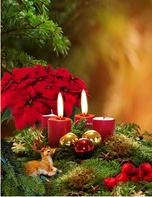German Food Guide
|
 |
| |
Traditional Christmas Eve Meals
On December 7th we began a series on traditional German dishes for Christmas Eve. The meal on Christmas Eve in Germany is usually a simple one - something that doesn't take much time to prepare. Read more about Christmas Eve traditions on December 7th's page.
Traditional Christmas Eve Meal #3: Carp
Another classic Christmas Eve meal is carp. The Christmas Carp (Weihnachtskarpfen) originates during a time when the Christian and Catholic churches required a pre-Christmas fast. This meant no meat was allowed until Christmas Day. Fish was allowed, and since the carp was thought to symbolize water, renewal, life, and fruitfulness, it quickly became a favorite meal for Christmas Eve.
An old custom related to the Christmas Carp is to take the fish's bones and place then under a fruit tree on December 25th. This is supposed to bring a good harvest of fruit in the next year.
The following recipe for the Christmas Carp comes from Franconia (Franken), a region in Southern Germany.
Carp
(Weihnachtskarpfen)
1 large (2 -2 1/2 pound) Carp, cleaned, de-scaled, and insides removed
2 tablespoons Flour
Sunflower Oil (about 8 tablespoons)
Salt and Pepper
Preheat oven to 425°F (220°C). Brush an oven-safe frying pan with oil.
Wash the carp with cold water, inside and out. Pat dry with a towel or paper towels. Brush the carp with 2 tablespoons of oil. Season the carp with salt and pepper, both inside and outside, then sprinkle the outside of the carp with flour.
Place carp on the prepared frying pan and put this in the oven. Bake for 35 minutes or until golden brown. During this baking time, occassionally brush the fish with additional oil.
Carp is often served with Potato Salad.
|

Incense smokers (Räuchermännchen) are popular during Christmas time in Germany. These are small wooden figures, which comes apart. Inside, a mini incense cone is placed and lighted. This produces smoke, which comes out of the small whole in the figure's face, to make it look like he is smoking a pipe. The incense cones come in a variety of fragrances, such as lavender, pine, violet, orange, etc.
Traditional German incense smokers come from Germany's Ore Mountain region in state of Saxony (Sachsen). Their origins date back to at least 1830. Originally, the figures resembled "everyday people." Today, they represent various occupations, such salesmen, bakers, foresters, miners, chimney sweepers, farmers, doctors, etc.
|
|
|

| |
"Advent, Advent, die zweite Kerze brennt ..."
Advent, Advent, the second candle burns |
Today is the Second Advent. The first and second candles are lit on the Advent Wreath.
The official theme of today in Catholic and Christian churches is hope and anticipation for the second coming of Christ.
|

|
|
|
|